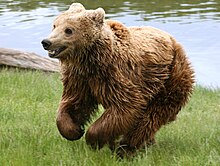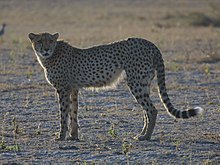User:Tosetemi David Aregbe

QUICK FACTS ABOUT ANIMALS: ALLIGATOR Class: Reptilia
Order: Crocodylia
Family: Alligatoridae
Genus: Alligator
Species: mississipiensis (American)
Conservation Concerns The Chinese alligator is endangered due to habitat destruction and capture programs. Range Southeastern United States and the Yangtze River Basin of China. Habitat Freshwater lakes, swamps, rivers.
Size American alligators measure up to 6 m (20 ft) long and weigh up to 250 kg (550 lb). Chinese alligators measure up to 2 m (6.6 ft) and weigh up to 23 kg (50 lb). Feeding Habits Alligators are carnivores; they eat fish, birds, turtles, frogs, and small mammals. Young alligators eat worms, small fish, and insects. Offspring The female alligator lays 30 to 40 eggs in a nest built of mud and plant material. The female guards the eggs as they incubate in the sun for about 60 days. Life Span Up to 50 years.
Did You Know Alligators communicate using grunts, bellows, hisses, and other vocalizations. Unlike crocodiles, the alligator's two large lower teeth are hidden when its jaw is closed. The American alligator has webbed feet; the Chinese alligator does not.
Ant
Class: Insecta

Order: Hymenoptera
Family: Formicidae
Conservation Concerns 45 species are at risk due to habitat destruction.
Range Almost all parts of the world; most abundant in the tropics.
Habitat Almost all parts of the world; most abundant in the tropics.
Feeding Habits Most ants are omnivores; they eat plant juices, seeds, fruits, other insects, and honeydew, a sugary liquid secreted by aphids. Offspring Only queen ants lay eggs. Ants pass through egg, larva, pupa, and adult stages.
Life Span Less than six months on average; some worker and queen ants live for several years. Did You Know Leaf cutter ants grow fungus for food. They collect plant material to fertilize the fungus in their nests. Male ants die soon after breeding with the queen ant.
Most queen ants have wings that they tear off after mating. Ants use scent trails to find their way back to their nest. Army ants travel in long, narrow columns in search of prey.
BEAR

Class: Mammalia
Order: Carnivora
Family: Ursidae
Genus/Species: Ailuropoda melanoleuca (giant panda)
Tremarctos oratus (spectacled bear)
Ursus malayanus (sun bear)
Melursus ursinus (sloth bear)
Ursus thibetanus (Asiatic black bear)
Ursus americanus (American black bear)
Ursus arctos (brown bear)
Ursus maritimus (polar bear)
Names Male: Boar Female: Sow Young: Cub
Conservation concerns Endangered in some parts of the world due to illegal hunting and habitat destruction. Range North America, South America, Europe, and Asia. Habitat Mountain, forest, and arctic wilderness.
Size Brown bears and polar bears are the largest bears, some growing to a length of 2 m (7 ft) or more and weighing 800 kg (1,760 lb). Sun bears are the smallest type of bear, growing about 1.5 m (5 ft) in length and weighing no more than 66 kg (146 lb). Feeding Habits Bears are classified as carnivores, or meat eaters, although different species vary widely in their feeding habits. Polar bears feed largely on seals, while other bears are generally omnivorous, eating plants, fruits, nuts, insects, fish, birds, and small to large mammals. Offspring Females give birth to litters of one to three cubs after a gestation of seven to nine months, depending on the species. Lifespan About 25 to 40 years.
Did You Know Bears have a keen sense of smell that is seven times more powerful than that of dogs. Bears have an excellent memory that helps them return from afar to an abundant food location year after year. After bears mate, the bear embryo undergoes delayed implantation, in which it halts development and becomes inactive for as long as six months before implanting in the mother's uterus. Bear attacks are extremely rare and most result when a human surprises a bear, provoking it to respond defensively.
Black Widow Spider
Class: Arachnida
Order: Araneae

Family: Theridiidae
Genus: Latrodectus
Range: Common in the tropics and parts of North and South America.
Habitat Dark, protected crevices. Size Females grow to 1.2 cm (0.5 in); males are smaller, with longer legs in proportion to their body. Feeding Habits Black widow spiders are carnivores; they feed on insects they catch in their webs. Offspring The female spider deposits up to 750 eggs in an egg sac. The eggs hatch after two to four weeks. Life Span About one to two years.
Did You Know Black widows prefer to stay away from people葉hey only bite in defense. The black widow is the most poisonous spider in the United States. Only female black widows are dangerous to people. Contrary to popular belief, the female black widow spider usually does not kill her partner after mating.
Blue Whale
Class: Mammalia
Order: Cetacea
Family: Balaenopteridae

Genus: Balaenoptera
Species: musculus
Names male: bull
female: cow
young: calf
group: pod
Conservation Concerns Endangered due to hunting. Range Oceans throughout the world. Habitat Tropical waters in winter, arctic or antarctic latitudes in summer. Size Length: over 24 m (80 ft)
Weight: about 150 metric tons Females tend to grow larger than males. Feeding Habits Blue whales are carnivores; they mainly eat small shrimp-like animals called krill. Blue whales use plates in their mouths, called baleen, to strain great quantities of krill from the water. Offspring After a gestation period of about 11 months, the female usually gives birth to one calf. Life Span Up to 100 years.
Did You Know During the summer, a blue whale can eat about 40 million krill a day預bout 3600 kg (7940 lb) of food. Blue whales are the largest animals of all time.
A blue whale can spout water up to 9 meters (30 ft) high. A baby blue whale gains about 90 kg (200 lb) a day.
Cheetah

Class: Mammalia
Order: Carnivora
Family: Felidae
Genus: Acinonyx
Species: jubatus
Names young: cub
group of males: coalition
group of mother and young: family
Conservation Concerns Endangered due to hunting and habitat destruction.
Range Africa south of the Sahara Desert and Iran.
Habitat Open plains and grasslands in semi-desert regions. Size Length: 173 to 218 cm (68 to 86 in), including the tail Weight: 39 to 65 kg (86 to 143 lb).
Feeding Habits Cheetahs are carnivores; their diet includes antelope, wildebeest, hares, and zebra. They hunt during the day, relying on acute eyesight and bursts of speed to catch prey. Offspring After a gestation period of about 90 to 95 days, the female gives birth to four to five cubs, and sometimes as many as eight. The young leave the mother when they are 14 to 18 months old. Life Span Up to 12 years in the wild.
Did You Know The cheetah's long skull, large nasal passages, and large lungs help it breathe when running. A cheetah's footpads have grooves for better traction at high speeds.
The cheetah is one of the fastest land animals. It can reach a top speed of more than 97 km/h (60 mph) in 2 to 3 seconds, and maintain it for 300 m (1,000 ft). The cheetah's long tail acts as a balance and aids in high-speed turns. Cheetahs always kill their prey with a bite to the neck.
